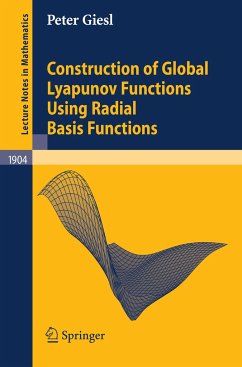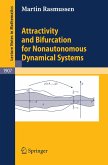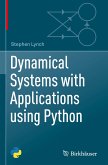This book combines two mathematical branches: dynamical systems and radialbasisfunctions.Itismainlywrittenformathematicianswithexperience in at least one of these two areas. For dynamical systems we provide a method to construct a Lyapunov function and to determine the basin of attraction of an equilibrium. For radial basis functions we give an important application for the approximation of solutions of linear partial di?erential equations. The book includes a summary of the basic facts of dynamical systems and radial basis functions which are needed in this book. It is, however, no introduction textbook of either area; the reader is encouraged to follow the references for a deeper study of the area. The study of di?erential equations is motivated from numerous appli- tions in physics, chemistry, economics, biology, etc. We focus on autonomous n di?erential equations x ? = f(x), x? R which de?ne a dynamical system. The simplest solutions x(t) of such an equation are equilibria, i.e. solutions x(t)= x which remain constant. An important and non-trivial task is the 0 determination of their basin of attraction. The determination of the basin of attraction is achieved through sublevel sets of a Lyapunov function, i.e. a function with negative orbital derivative. TheorbitalderivativeV (x)ofafunctionV(x)isthederivativealongsolutions of the di?erential equation. In this book we present a method to construct Lyapunov functions for an equilibrium. We start from a theorem which ensures the existence of a
From the reviews:
"In this book the author presents a new method to construct such a Lyapunov function using radial basis functions. Besides an introduction to both areas and a detailed description of the method, it contains error estimates and a lot of examples. This book is intended for researchers and advanced students from both dynamical systems and radial basis functions." (Alexander O. Ignatyev, Zentralblatt MATH, Vol. 1121 (23), 2007)
"In the monograph under review a method for the numerical computation of Lyapunov functions is developed. ... one cannot only learn about how to compute Lyapunov functions, but can in fact learn a lot about their theoretical properties and about approximation methods using radial basis functions. ... In summary, the book can be strongly recommended to anyone interested in either Lyapunov functions or in approximation methods using radial basis functions ... . it is also very suitable for self study." (Lars Grüne, Mathematical Reviews, Issue 2009 i)
"In this book the author presents a new method to construct such a Lyapunov function using radial basis functions. Besides an introduction to both areas and a detailed description of the method, it contains error estimates and a lot of examples. This book is intended for researchers and advanced students from both dynamical systems and radial basis functions." (Alexander O. Ignatyev, Zentralblatt MATH, Vol. 1121 (23), 2007)
"In the monograph under review a method for the numerical computation of Lyapunov functions is developed. ... one cannot only learn about how to compute Lyapunov functions, but can in fact learn a lot about their theoretical properties and about approximation methods using radial basis functions. ... In summary, the book can be strongly recommended to anyone interested in either Lyapunov functions or in approximation methods using radial basis functions ... . it is also very suitable for self study." (Lars Grüne, Mathematical Reviews, Issue 2009 i)








